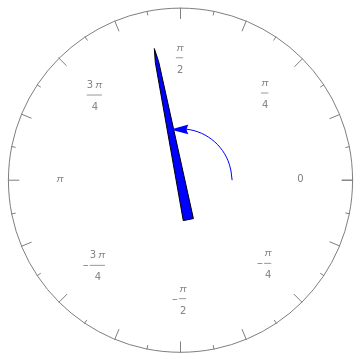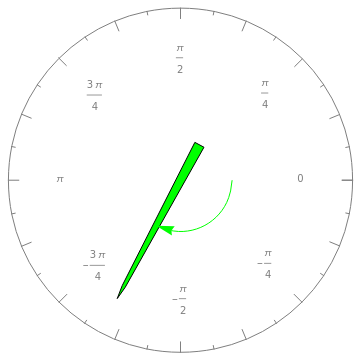Manipulability Ellipsoid of a Robot Arm
Manipulability Ellipsoid of a Robot Arm
Manipulability of a robot is the capacity to change the end effector's position as a function of the joint configuration[1]. A larger manipulability measure indicates a greater range of possible motions at that configuration. The manipulability measure reduces to zero when the robot is in a singular configuration and cannot generate velocities in at least one direction.
The manipulability ellipsoid includes all possible velocities normalized for a unit input at a given robot configuration. These velocities are calculated using the robot’s velocity Jacobian.
In this Demonstration, you can adjust a three-link elbow manipulator’s configuration to see how the joint configuration affects the manipulability. For singular configurations, the Jacobian loses rank, causing the manipulability ellipsoid to lose dimensions to either an ellipse or a line.
Details
Details
Calculating the manipulability requires defining the robot configuration in terms of joint angles (forward kinematics) and then calculating how joint velocities generate velocity of the end effector (velocity kinematics).
The configuration is defined using transformation matrices derived using the Denavit–Hartenberg convention. The three joints of the elbow manipulator allow three positional degrees of freedom, and the location (origin) of each joint is determined from these transformation matrices. These origins are combined with the axes of rotation from the same transformation matrices to develop the velocity Jacobian, which relates the end effector velocity to the rate of change in the joint positions. The velocity Jacobian used in this Demonstration is given in[2, eq. 4.98, p. 144]. It is a function of the rotational position of each of the three joints, described by the variables , , and .
J
θ
1
θ
2
θ
3
The velocity Jacobian is ,
J=
(- r 2 c 2 r 3 c 23 s 1 | - r 2 c 1 s 2 r 3 c 1 s 23 | - r 3 c 1 s 23 |
c 1 r 2 c 2 r 3 c 23 | - r 2 s 1 s 2 r 3 s 1 s 23 | - r 3 s 1 s 23 |
0 | r 2 c 2 r 3 c 23 | r 3 c 23 |
where is shorthand for , is shorthand for , and so on, and the lengths of links 2 and 3 are and .
s
1
sin()
θ
1
c
23
cos(+)
θ
2
θ
3
r
2
r
3
The manipulability measure is calculated as the product of the diagonal elements in the matrix that results from the singular value decomposition of the velocity Jacobian, . It may also be defined relative to the determinant of the Jacobian as . From this definition, it is clear that when the determinant of the Jacobian is zero. This occurs when the manipulator is in a singular configuration. The determinant of the Jacobian is . When the elbow manipulator is in the configuration, , the Jacobian has rank 2, and the three-dimensional ellipsoid flattens to a two-dimensional ellipse. At the configuration, , the Jacobian has rank 1, and the ellipsoid collapses to a line. Snapshot 1 gives a three-dimensional ellipse, snapshot 2 a two-dimensional ellipse, and snapshot 3 a one-dimensional ellipse.
σ
i
Σ
μ=
m
∏
i=1
σ
i
μ=
det(J)
T
J
μ=0
J=-(+)
r
2
r
3
r
2
c
2
r
2
c
23
s
3
[,,kπ]
θ
1
θ
2
k∈
[,π/2+kπ,jπ]
θ
1
(j,k)∈
2
References
References
[1] J. Martinez, "Manipulability Ellipsoids in Robotics," Engineer JAU (blog). (May 26, 2016) engineerjau.wordpress.com/2013/05/04/advanced-robotics-manipulability-ellipsoids.
[2] M. W. Spong, S. Hutchinson, and M. Vidyasagar, Robot Modeling and Control, Hoboken, NJ: John Wiley and Sons, 2006.
External Links
External Links
Permanent Citation
Permanent Citation
Aaron T. Becker, Mary Burbage
"Manipulability Ellipsoid of a Robot Arm"
http://demonstrations.wolfram.com/ManipulabilityEllipsoidOfARobotArm/
Wolfram Demonstrations Project
Published: June 24, 2016


